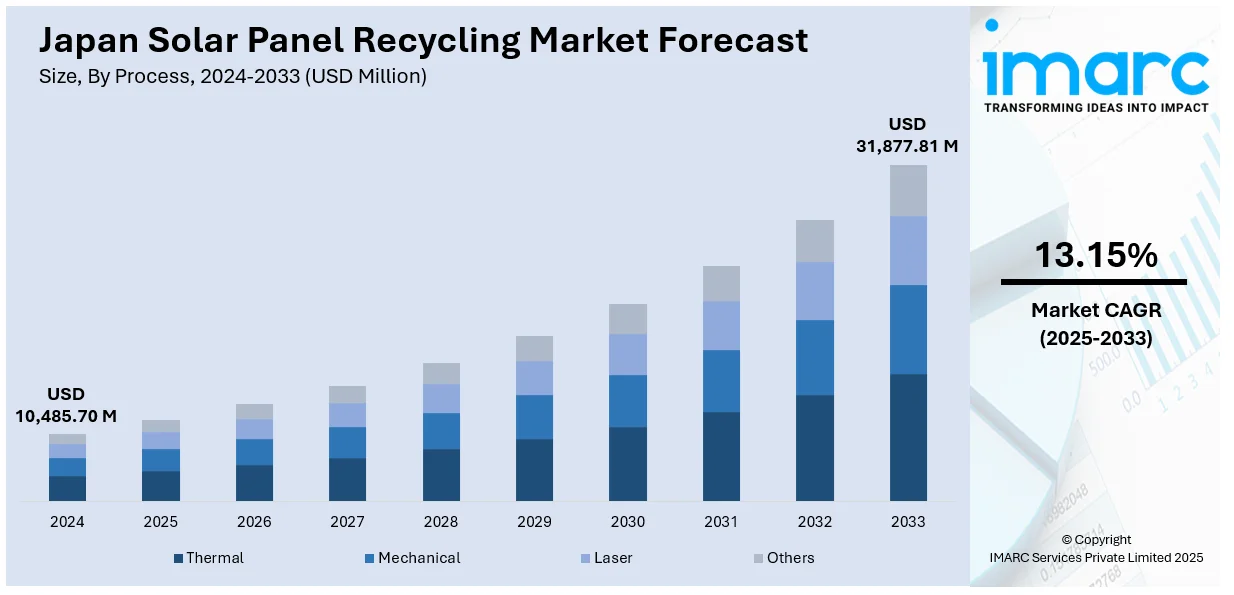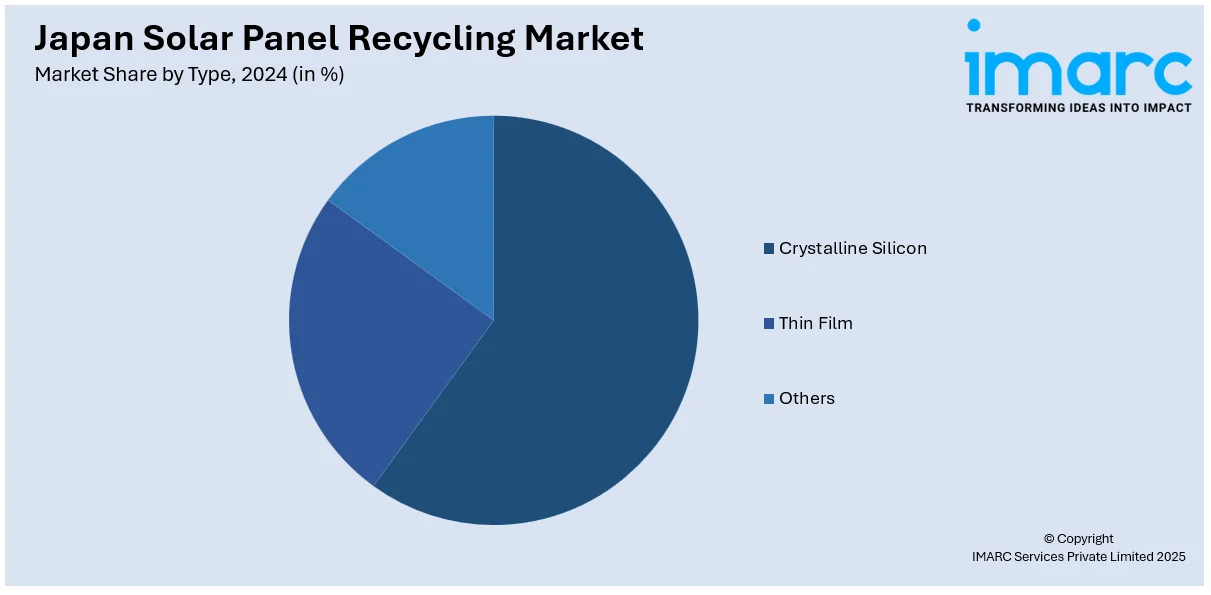
Japan Solar Panel Recycling Market Size, Share, Trends and Forecast by Process, Type, Material, Shelf Life, and Region, 2025-2033
Japan Solar Panel Recycling Market Overview:
The Japan solar panel recycling market size reached USD 10,485.70 Million in 2024. Looking forward, IMARC Group expects the market to reach USD 31,877.81 Million by 2033, exhibiting a growth rate (CAGR) of 13.15% during 2025-2033. The market is driven by the rise in end-of-life solar panels from Japan’s early 2010s solar boom, necessitating efficient recycling solutions to manage growing waste volumes. Regulatory mandates, such as the Act on Recycling of Solar Panels (2023), further accelerate demand by enforcing proper disposal and material recovery standards. Additionally, strong public-private collaborations and investments in advanced recycling technologies enhance infrastructure and resource recovery, further augmenting the Japan solar panel recycling market share.
|
Report Attribute
|
Key Statistics
|
|---|---|
|
Base Year
|
2024 |
|
Forecast Years
|
2025-2033
|
|
Historical Years
|
2019-2024
|
| Market Size in 2024 | USD 10,485.70 Million |
| Market Forecast in 2033 | USD 31,877.81 Million |
| Market Growth Rate 2025-2033 | 13.15% |
Japan Solar Panel Recycling Market Trends:
Rising Demand for Solar Panel Recycling Due to Aging Installations
The market is experiencing significant growth due to the increasing number of aging photovoltaic (PV) systems. Following the country’s solar boom in the early 2010s, many panels are now reaching their end-of-life (EOL) phase, typically after 20-25 years of operation. During fiscal year 2020, Japan's solar photovoltaic (PV) systems on rooftops gave homes savings of JPY 143,422 (USD 1,352), leading to a net gain of JPY 37,422 (USD 353) due to reduced electricity bills and the sale of excess power. With annual installations estimated to hit 8 to 14 GW by 2030, Japan's solar panel recycling industry is poised to grow to help sustainably handle end-of-life PV systems. The new regulations in Tokyo mandating solar panels on residential properties starting in April 2025 underscore the necessity for a strong recycling framework to aid Japan in achieving its net-zero objectives. As a result, the volume of decommissioned solar panels is expected to rise, driving demand for efficient recycling solutions. Japan’s government has also introduced stricter regulations on solar waste management, including the Act on Recycling of Solar Panels (2023), which mandates proper disposal and material recovery. Recycling firms are investing in advanced technologies to recover valuable materials, including silicon, silver, and glass, reducing environmental impact and supporting a circular economy. Additionally, manufacturers are adopting eco-design principles to enhance recyclability. With Japan’s strong emphasis on sustainability and resource efficiency, the solar panel recycling market is poised for steady expansion as more PV systems approach their EOL stage.

Growth in Public and Private Sector Collaboration for Recycling Infrastructure
The increasing collaboration between public institutions and private companies to develop robust recycling infrastructure is propelling the Japan solar panel recycling market growth. The Japanese government is actively promoting partnerships with recycling firms, research institutions, and solar manufacturers to establish efficient collection and processing systems. Initiatives such as the Japan Photovoltaic Energy Association (JPEA)’s recycling program aim to streamline the handling of end-of-life panels while ensuring compliance with environmental standards. Japan is preparing for a significant amount of solar panel waste that is projected to amount to 500,000 tons annually in the early 2040s. To meet this, legislation introduced for 2025 will mandate recycling by forcing producers and importers to pay for recycling, and a third party will be entrusted with the handling of finances. This program, which TEPCO's Tokyo Power Technology Ltd. also backs, aims to divert 60% of recyclable glass from landfills and thus increase investment in the solar panel recycling sector in Japan. Private companies are also stepping up efforts, with major players launching specialized recycling facilities. These facilities utilize advanced separation and material recovery techniques to maximize resource reuse. Furthermore, financial incentives and subsidies are encouraging businesses to adopt sustainable disposal practices. As Japan continues to prioritize renewable energy and waste reduction, public-private partnerships will play a crucial role in shaping a scalable and cost-effective solar panel recycling ecosystem.
Japan Solar Panel Recycling Market Segmentation:
IMARC Group provides an analysis of the key trends in each segment of the market, along with forecasts at the country and regional levels for 2025-2033. Our report has categorized the market based on process, type, material, and shelf life.
Process Insights:
- Thermal
- Mechanical
- Laser
- Others
The report has provided a detailed breakup and analysis of the market based on the process. This includes thermal, mechanical, laser, and others.
Type Insights:

- Crystalline Silicon
- Thin Film
- Others
A detailed breakup and analysis of the market based on the type have also been provided in the report. This includes crystalline silicon, thin film, and others.
Material Insights:
- Metal
- Glass
- Aluminum
- Silicon
- Others
The report has provided a detailed breakup and analysis of the market based on the material. This includes metal, glass, aluminum, silicon, and others.
Shelf Life Insights:
- Normal Loss
- Early Loss
A detailed breakup and analysis of the market based on the shelf life have also been provided in the report. This includes normal loss and early loss.
Regional Insights:
- Kanto Region
- Kansai/Kinki Region
- Central/ Chubu Region
- Kyushu-Okinawa Region
- Tohoku Region
- Chugoku Region
- Hokkaido Region
- Shikoku Region
The report has also provided a comprehensive analysis of all the major regional markets, which include Kanto Region, Kansai/Kinki Region, Central/ Chubu Region, Kyushu-Okinawa Region, Tohoku Region, Chugoku Region, Hokkaido Region, and Shikoku Region.
Competitive Landscape:
The market research report has also provided a comprehensive analysis of the competitive landscape. Competitive analysis such as market structure, key player positioning, top winning strategies, competitive dashboard, and company evaluation quadrant has been covered in the report. Also, detailed profiles of all major companies have been provided.
Japan Solar Panel Recycling Market News:
- Ishizuka Glass Co., Ltd. and Kinjo Gakuin University launched the solaGlass project in September 2024, which seeks to recycle solar panel glass into tableware prototypes. The project aims to address the expected 350,000 tons of waste solar panels in Japan by the year 2035, projected to increase to 470,000 tons in 2042. The project, with involvement from ten students and Hokuyo Glass Co., Ltd., develops a circular economy through industry-academia collaboration, with a prototype presentation at the 2024 Japan Society for Design Science conference. This initiative improves Japan's solar panel recycling business by presenting cutting-edge glass recycling, backed by the Aichi Circular Economy Promotion Project Team.
Japan Solar Panel Recycling Market Report Coverage:
| Report Features | Details |
|---|---|
| Base Year of the Analysis | 2024 |
| Historical Period | 2019-2024 |
| Forecast Period | 2025-2033 |
| Units | Million USD |
| Scope of the Report |
Exploration of Historical Trends and Market Outlook, Industry Catalysts and Challenges, Segment-Wise Historical and Future Market Assessment:
|
| Processes Covered | Thermal, Mechanical, Laser, Others |
| Types Covered | Crystalline Silicon, Thin Film, Others |
| Materials Covered | Metal, Glass, Aluminum, Silicon, Others |
| Shelf Lives Covered | Normal Loss, Early Loss |
| Regions Covered | Kanto Region, Kansai/Kinki Region, Central/ Chubu Region, Kyushu-Okinawa Region, Tohoku Region, Chugoku Region, Hokkaido Region, Shikoku Region |
| Customization Scope | 10% Free Customization |
| Post-Sale Analyst Support | 10-12 Weeks |
| Delivery Format | PDF and Excel through Email (We can also provide the editable version of the report in PPT/Word format on special request) |
Key Questions Answered in This Report:
- How has the Japan solar panel recycling market performed so far and how will it perform in the coming years?
- What is the breakup of the Japan solar panel recycling market on the basis of process?
- What is the breakup of the Japan solar panel recycling market on the basis of type?
- What is the breakup of the Japan solar panel recycling market on the basis of material?
- What is the breakup of the Japan solar panel recycling market on the basis of shelf life?
- What is the breakup of the Japan solar panel recycling market on the basis of region?
- What are the various stages in the value chain of the Japan solar panel recycling market?
- What are the key driving factors and challenges in the Japan solar panel recycling market?
- What is the structure of the Japan solar panel recycling market and who are the key players?
- What is the degree of competition in the Japan solar panel recycling market?
Key Benefits for Stakeholders:
- IMARC’s industry report offers a comprehensive quantitative analysis of various market segments, historical and current market trends, market forecasts, and dynamics of the Japan solar panel recycling market from 2019-2033.
- The research report provides the latest information on the market drivers, challenges, and opportunities in the Japan solar panel recycling market.
- Porter's five forces analysis assist stakeholders in assessing the impact of new entrants, competitive rivalry, supplier power, buyer power, and the threat of substitution. It helps stakeholders to analyze the level of competition within the Japan solar panel recycling industry and its attractiveness.
- Competitive landscape allows stakeholders to understand their competitive environment and provides an insight into the current positions of key players in the market.
Need more help?
- Speak to our experienced analysts for insights on the current market scenarios.
- Include additional segments and countries to customize the report as per your requirement.
- Gain an unparalleled competitive advantage in your domain by understanding how to utilize the report and positively impacting your operations and revenue.
- For further assistance, please connect with our analysts.
 Request Customization
Request Customization
 Speak to an Analyst
Speak to an Analyst
 Request Brochure
Request Brochure
 Inquire Before Buying
Inquire Before Buying




.webp)




.webp)












